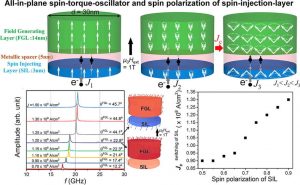R&D: Design Spin-Injection-Layer in All-in-Plane Spin-Torque-Oscillator for Microwave Assisted Magnetic Recording
Materials with smaller saturation magnetization in SIL reduce Jc
This is a Press Release edited by StorageNewsletter.com on January 7, 2019 at 2:14 pmJournal of Magnetism and Magnetic Materials has published an article written by H.Sepehri-Amim,W.Zhou, S.Bosu, Research Center for Magnetic and Spintronic Materials, National Institute for Materials Science, Tsukuba 305-0047, Japan, C.Abert, Christian Doppler Laboratory – Advanced Magnetic Sensing and Materials, University of Vienna, Austria, Y.Sakuraba, S.Kasai, D.Suess, and K.Hono, Research Center for Magnetic and Spintronic Materials, National Institute for Materials Science, Tsukuba 305-0047, Japan.
Click to enlarge
Abstract: “A new type of spin-torque-oscillator (STO), all-in-plane STO, is introduced for microwave assisted magnetic recording (MAMR) that consist of a spin-injection-layer (SIL) and a field-generating-layer (FGL) with an effective in-plane easy axis due to the shape anisotropy separated with a metallic spacer. In this device, electrons are injected from SIL to FGL while the magnetization of the SIL and FGL is saturated to the out-of-plane by the external magnetic field of ∼1.0 T. Micromagnetic simulations showed that the magnetization direction of SIL can be switched to the opposite direction to that of the applied external magnetic field by the use of spin-transfer-torque. This results in a larger spin accumulation in FGL and its oscillation with a large cone angle at a low bias current density. We designed SIL to reduce the critical current density, Jc, required for the magnetization switching of SIL. Materials with a smaller saturation magnetization in SIL reduce Jc. Smaller spin polarization of SIL leads to a larger spin accumulation in SIL with an opposite direction to the magnetization, resulting in a reduction of Jc. This enables magnetization switching of SIL in small Jc followed by oscillation of FGL with frequency above 20 GHz with a large out-of-plane oscillation cone angle of 45-50o. The validity of this finding was studied experimentally by developing STO with two SIL materials, Co2Fe(Al0.5Si0.5) Heusler alloy and Fe67Co33, the former has the B2 crystal structure with a large spin polarization and the latter has the A2 crystal structure with a smaller spin polarization. The magnetization configuration of SIL and FGL in STO with a diameter of ∼60 nm is investigated experimentally based on the field dependent resistance change and the oscillation behavior is discussed based on the micromagnetic simulations“.















 Subscribe to our free daily newsletter
Subscribe to our free daily newsletter

